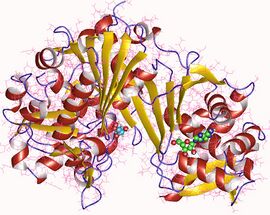Biology:Xylulokinase
| xylulokinase | |||||||||
|---|---|---|---|---|---|---|---|---|---|
 D-xylulokinase monomer, Human | |||||||||
| Identifiers | |||||||||
| EC number | 2.7.1.17 | ||||||||
| CAS number | 9030-58-4 | ||||||||
| Databases | |||||||||
| IntEnz | IntEnz view | ||||||||
| BRENDA | BRENDA entry | ||||||||
| ExPASy | NiceZyme view | ||||||||
| KEGG | KEGG entry | ||||||||
| MetaCyc | metabolic pathway | ||||||||
| PRIAM | profile | ||||||||
| PDB structures | RCSB PDB PDBe PDBsum | ||||||||
| Gene Ontology | AmiGO / QuickGO | ||||||||
| |||||||||
In enzymology, a xylulokinase (EC 2.7.1.17) is an enzyme that catalyzes the chemical reaction
- ATP + D-xylulose ⇌ ADP + D-xylulose 5-phosphate
Thus, the two substrates of this enzyme are ATP and D-xylulose, whereas its two products are ADP and D-xylulose 5-phosphate.
This enzyme belongs to the family of transferases, specifically those transferring phosphorus-containing groups (phosphotransferases) with an alcohol group as acceptor. The systematic name of this enzyme class is ATP:D-xylulose 5-phosphotransferase. Other names in common use include xylulokinase (phosphorylating), and D-xylulokinase. This enzyme participates in pentose and glucuronate interconversions.
Structural studies
As of late 2007, two structures have been solved for this class of enzymes, with PDB accession codes 2ITM and 2NLX.
Applications
Hydrogen production
In 2014 a low-temperature 50 °C (122 °F), atmospheric-pressure enzyme-driven process to convert xylose into hydrogen with nearly 100% of the theoretical yield was announced. The process employs 13 enzymes, including xylulokinase.[1][2]
References
- ↑ Martín Del Campo, J. S.; Rollin, J.; Myung, S.; Chun, Y.; Chandrayan, S.; Patiño, R.; Adams, M. W.; Zhang, Y. H. (2013-04-03). "Virginia Tech team develops process for high-yield production of hydrogen from xylose under mild conditions". Angewandte Chemie International Edition in English (Green Car Congress) 52 (17): 4587–90. doi:10.1002/anie.201300766. PMID 23512726. http://www.greencarcongress.com/2013/04/vt-20130403.html. Retrieved 2014-01-22.
- ↑ "High-yield production of dihydrogen from xylose by using a synthetic enzyme cascade in a cell-free system". Angewandte Chemie 52 (17): 4587–90. April 2013. doi:10.1002/anie.201300766. PMID 23512726.
Further reading
- "Structure and function of human xylulokinase, an enzyme with important roles in carbohydrate metabolism". The Journal of Biological Chemistry 288 (3): 1643–52. January 2013. doi:10.1074/jbc.m112.427997. PMID 23179721.
- Hickman J; Ashwell G (1958). "Purification and properties of D-xylulokinase in liver". J. Biol. Chem. 232 (2): 737–748. doi:10.1016/S0021-9258(19)77394-3. PMID 13549459.
- "D-Xylulokinase". Methods Enzymol. 9: 454–458. 1966. doi:10.1016/0076-6879(66)09093-1.
- "Xylose isomerase from Pasteurella pestis, strain A-1122". J. Am. Chem. Soc. 77 (6): 1663–1667. 1955. doi:10.1021/ja01611a074.
- "The role of xylulose 5-phosphate in xylose metabolism of Lactobacillus pentosus". The Journal of Biological Chemistry 218 (2): 753–68. February 1956. doi:10.1016/S0021-9258(18)65840-5. PMID 13295228.
 |

